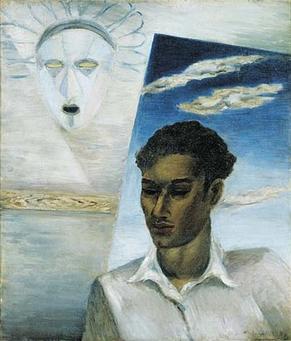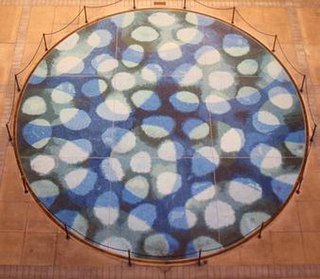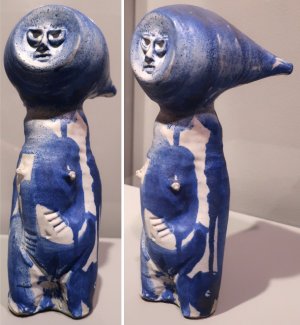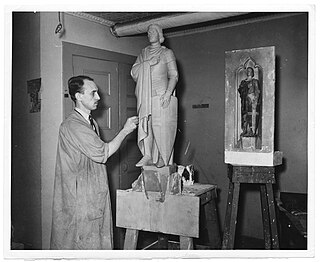Related Research Articles

The University of Hawaiʻi at Mānoa is a public land-grant research university in Mānoa, a neighborhood of Honolulu, Hawaii. It is the flagship campus of the University of Hawaiʻi system and houses the main offices of the system. Most of the campus occupies the eastern half of the mouth of Mānoa Valley, with the John A. Burns School of Medicine located adjacent to the Kakaʻako Waterfront Park.

The Honolulu Museum of Art is an art museum in Honolulu, Hawaiʻi. The museum is the largest of its kind in the state, and was founded in 1922 by Anna Rice Cooke. The museum has one of the largest single collections of Asian and Pan-Pacific art in the United States, and since its official opening on April 8, 1927, its collections have grown to more than 55,000 works of art.

Louis Henri Jean Charlot was a French-born American painter and illustrator, active mainly in Mexico and the United States.

Alfred Preis was an Austrian-born American architect best known for designing the USS Arizona Memorial in Pearl Harbor.

The Hawaiian archipelago consists of 137 islands in the Pacific Ocean that are far from any other land. Polynesians arrived there one to two thousand years ago, and in 1778 Captain James Cook and his crew became the first Europeans to visit Hawaii. The art created in these islands may be divided into art existing prior to Cook’s arrival; art produced by recently arrived westerners; and art produced by Hawaiians incorporating western materials and ideas. Public collections of Hawaiian art may be found at the Honolulu Museum of Art, the Bishop Museum (Honolulu), the Hawaii State Art Museum and the University of Göttingen in Germany.

Isami Doi was an American printmaker and painter.

Juliette May Fraser was an American painter, muralist and printmaker. She was born in Honolulu, which was then the capital city of the Kingdom of Hawaii. After graduating from Wellesley College with a degree in art, she returned to Hawaii for several years. She continued her studies with Eugene Speicher and Frank DuMond at the Art Students League of New York and at the John F. Carlson School of Landscape Painting in Woodstock, New York. She returned to Hawaii to teach, like her parents who had both come to Hawaii as educators. Fraser designed the Hawaii Sesquicentennial half dollar, which was engraved by Chester Beach and issued in 1928.

Marguerite Louis Blasingame Charles (1906–1947) was an American sculptor and painter. Born Marguerite Louis in Honolulu in 1906, she graduated from the University of Hawaii and went on to earn an M.A. in fine art from Stanford University in 1928. The artist then returned to Hawaii, where she became an established sculptor of figural works, many of them bas-reliefs in wood and stone. Her depictions were usually sinuous in contour with simplified anatomy. During the Great Depression, Blasingame was a Works Progress Administration artist and filled many commissions for architectural panels.

Tadashi Sato was an American artist. He was born in Kaupakalua on the Hawaiian island of Maui. His father had been a pineapple laborer, merchant, and calligrapher, and Tadashi's grandfather was a sumi-e artist.

Satoru Abe is a Japanese American sculptor and painter.
Reuben Tam was an American landscape painter, educator, poet and graphic artist.

Mamoru Sato is an American modernist sculptor. He was born in El Paso, Texas in 1937. He initially majored in aeronautical engineering but switched to art, receiving a BA in fine art in 1963 and an MFA in sculpture in 1965, both from the University of Colorado. He taught at the University of Hawaii at Manoa in 1965. During the summer of 1969, he worked with Tony Smith at UH. Smith titled a piece in his For... series for Sato: For M.S.

Fred H. Roster was an American sculptor known for his mixed media narrative sculptures.

Claude Horan was an American ceramic and glass artist who was born in Long Beach, California. He received a BA from San Jose State University in 1942 and an MA degree in art from Ohio State University in 1946. His wife Suzi Pleyte Horan collaborated on many of the larger projects. He was a lifeguard and longboard surfer in Santa Cruz in the late 1930s, and is credited with naming Steamer Lane.
Ken Shutt was an American sculptor and watercolorist who was born in Long Beach, California. He grew up in Whittier, California, and graduated from Pasadena City College, the Art Center College of Design and the Chouinard Art Institute. He moved to Hawaii in 1963, and lived there until 1995. He returned to California in 1995, to be near his foundry, when he was commissioned to create a bronze sculpture for the entrance of Sea Life Park Hawaii. He died 2010, at age 81, in Atascadero, California.

Roy Elwood King was an American born sculptor, painter and civil engineer.
Kenneth Wayne Bushnell was an American visual artist, who was born in Los Angeles. He earned a BA from the University of California, Los Angeles in 1958, and then moved to Hawaii, where he received an MFA from the University of Hawaiʻi in 1961. He taught painting at the University of Hawaiʻi at Mānoa from 1961 to 1981, and was appointed chairman of the Art Department in 1991. He married fellow artist Helen Gilbert in 1995. Bushnell eventually earned the title of professor emeritus, living in Honolulu.

Eli Raphael Marozzi (1913–1999) was a sculptor, ceramist, teacher, and illustrator.
References
- ↑ "Obituary of Edward Malcolm Mick Brownlee". tillamookheadlightherald.com. Retrieved 21 March 2019.
- ↑ "Sculptor paved way for state arts agency". Honolulu Star-Advertiser: A24. Dec 20, 2013. Retrieved 21 March 2019.
- ↑ Bitner, Arnold (2001). Hawaiʻi Tropical Rum Drinks by Don the Beachcomber. Honolulu: Mutual Publishing.
- ↑ "Island Idol Sculptor". Paradise of the Pacific. Holiday Edition: 56. 1958.
- ↑ "Royal Kona Resort hosts second annual Tiki Festival". westhawaiitoday.com. 15 November 2018. Retrieved 21 March 2019.
- ↑ "Waikikian". tikiarchitecture.blogspot.com. Retrieved 21 March 2019.
- ↑ "RIP Mick Brownlee". tikiroom.com. Retrieved 21 March 2019.
- ↑ Brownlee, Edward M. (December 1967). "Art: The Complete Education". Educational Perspective: 5–8. hdl:10125/48344.
- ↑ "Edward Malcolm "Mick" Brownlee". Tillamook Headlight-Herald.
- ↑ "Public Art Archive". publicartarchive.org. Retrieved 21 March 2019.
- Haar, Francis and Neogy, Prithwish, "Artists of Hawaii: Nineteen Painters and Sculptors", University of Hawaiʻi Press, 1974, pages 26-33.
- Radford, Georgia and Warren Radford, "Sculpture in the Sun, Hawaiʻi Art for Open Spaces", University of Hawaiʻi Press, 1978, page 92.
- Yoshihara, Lisa A., Collective Visions, 1967-1997, Hawaii State Foundation on Culture and the Arts, Honolulu, Hawaii, 1997, pages 140-141.